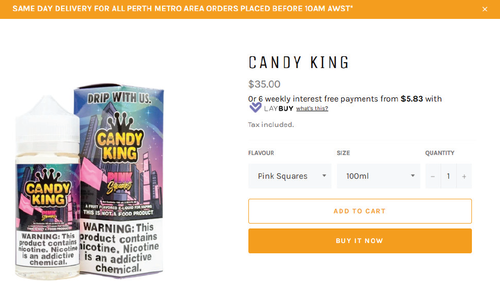Charlotte’s accessible web: how West Australian children and adolescents can access e-cigarettes online
The advent of electronic cigarettes (e-cigarettes) has amassed a new generation of child and adolescent nicotine users globally.1 By design, the burgeoning e-cigarette industry has attracted a young and naive consumer base, crafting colourful designs and sweetened flavours while harnessing social marketing and influencing.1 Among high school students in Western Australia, ever-use or experimentation with e-cigarettes has grown to 14%.2
Internationally, online retailers have become an accessible means to purchase e-cigarettes, with web traffic to online stores buoyed by social media and other marketing strategies such as online promotion codes, reward schemes and new customer discounts.3 Of concern, there are few barriers to purchasing by young people. One US study reported that two-thirds of online vendors had no age identification requirements at all,4 and even when websites ask consumers to confirm their age, verification is easily falsified.5 While the extent of online e-cigarette purchases by Australian children and adolescents is unknown, estimates suggest that at least one-quarter of e-cigarettes obtained by adults are purchased online.6 Plausibly, this could be higher among tech-native children and adolescents.
The contents of e-cigarette products purchased online are also suspect. An analysis of online US e-cigarette sales found that only 60% of shipped packages included product information inside, and only 44% included a product health warning, many of which were unsupported by current health advice.7 Such evidence about the lack of deterrents to purchasing by young people, and the dearth of accurate product information, raises concerns about whether the situation in Australia is similar. To date, however, nothing has been documented.
To assess the e-cigarette e-commerce market in WA, an audit was conducted of Australian online e-cigarette retailers that advertised delivery to Perth. Retailers were identified in February 2020 by conducting internet searches on a Google search engine using common e-cigarettes search terms (“e-cigarette”, “e-cig”, “vape” and “vaping”) and terms to identify retailers (“store”, “shop”, “online”, “WA” and “Perth”). After excluding 17 retailers that were located internationally, deactivated, or social media based, 30 eligible online retailers were identified and audited. Of these, 15 were based in WA and 15 interstate (as determined by the main business address). The audit was conducted by one researcher, with results verified by checking web browser screenshots that were saved and archived for each online store.
In the audit, only half (50%) of the 30 retailers required age verification, which often comprised users confirming they were over 18 or inputting their age or date of birth. While there are no age requirements laws for e-cigarettes sold in WA, such laws do exist in other states, and all Australian jurisdictions require age verification for the purchase of combustible cigarettes.
Of concern, almost one-quarter (23%) of the websites audited provided information on where and how to purchase liquid nicotine, which is illegal to sell in Australia; many websites included links to partnering international stores to assist clients in skirting Australian regulations. A number of websites (13%) also described to users how to mix liquid nicotine with purchased manufactured products.
An unexpected finding was the inconsistencies in product displays. More than half of stores displayed images of products containing nicotine (57%), despite nearly three-quarters of retailers (73%) stating that they did not sell nicotine-containing products (see Figure 1). In WA retailers, where it is illegal to sell complete e-cigarette devices, 27% of websites marketed such products. It is unclear whether online stores are actually selling these illegal products or whether their advertising has carelessly used incorrect images.

Candy King’s” fruit flavoured “Pink Squares” nicotine e-liquid being sold online to customers in WA. This website purported in their customer FAQ that they did not sell nicotine products. It is unclear, therefore, whether this product genuinely contains nicotine or not.
A clear theme identified was the variety of promotional tactics used to attract sales. This included promotional codes (13%), discounting (60%), competitions and prizes (13%), free shipping (53%), loyalty schemes (17%), and advertising material supplied by a manufacturer (63%). It is interesting that many of these advertising strategies are reminiscent of the now-outlawed tactics once used for combustible tobacco products. Manufacturer advertising materials, in particular, have already been linked to e-cigarette uptake among young people elsewhere.1
Congruent with US evidence, product health information was scant.7 Only 13% of the WA websites provided any health or safety information, compared with 33% of interstate stores. Among those that did include health-related information, it is pertinent to note that several cited a website known for recent e-cigarette industry funding.8
This is the first Australian audit of its kind and highlights significant concerns in the online retail of e-cigarettes in Australia. Children and adolescents who wish to purchase e-cigarettes in Australia face few obstacles and the plethora of promotional strategies used by retailers is disturbing. These issues are plausibly attributable to poor industry self-regulation, as well as gaps in state and federal legislation relating to e-cigarettes, though it should be noted that the Australian Therapeutic Goods Administration is currently exploring regulatory options which could significantly dampen access through online retailers.9
In the meantime, further research is needed to illuminate the scale of e-cigarette e-commerce in Australia, and greater scrutiny of product content disclosure, promotional tactics and youth access is warranted. Regulators are encouraged to continue carefully examining loopholes and to increase measures for online retailers which avert the purchasing and uptake of e-cigarettes by children and adolescents.




